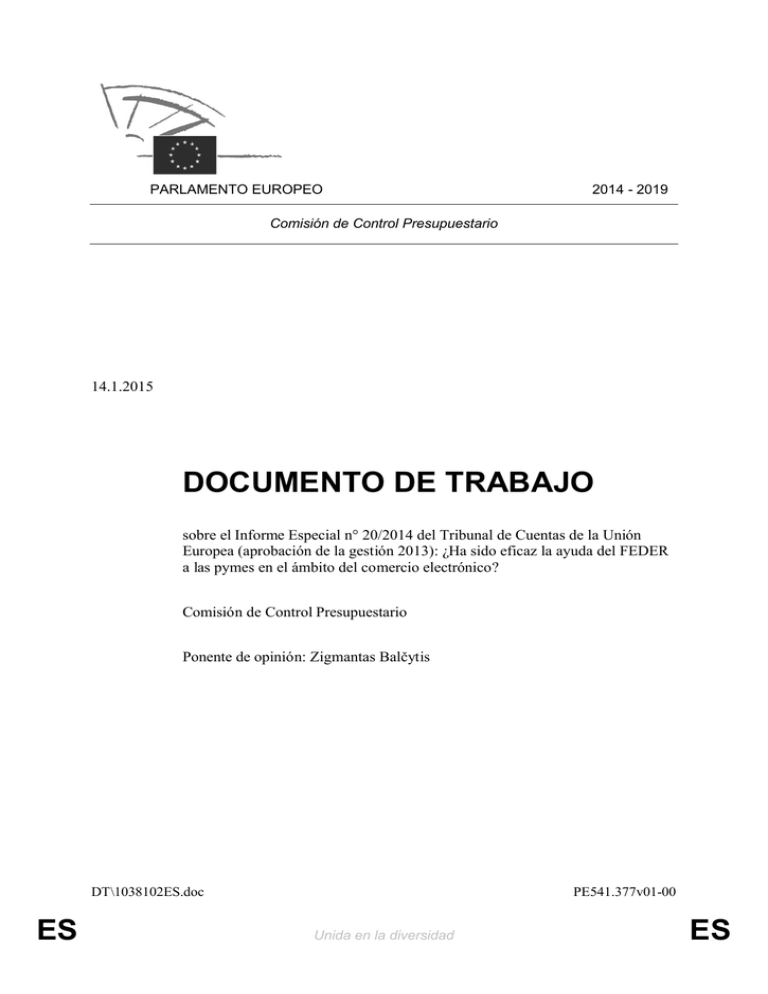ES ES DOCUMENTO DE TRABAJO
Anuncio

PARLAMENTO EUROPEO 2014 - 2019 Comisión de Control Presupuestario 14.1.2015 DOCUMENTO DE TRABAJO sobre el Informe Especial n° 20/2014 del Tribunal de Cuentas de la Unión Europea (aprobación de la gestión 2013): ¿Ha sido eficaz la ayuda del FEDER a las pymes en el ámbito del comercio electrónico? Comisión de Control Presupuestario Ponente de opinión: Zigmantas Balčytis DT\1038102ES.doc ES PE541.377v01-00 Unida en la diversidad ES E-commerce technologies are viewed as a way of accelerating economic growth, of further developing the Single Market and of speeding up European integration. The Commission has therefore increasingly placed importance on the need to foster e-commerce developments, in particular through one of its flagship initiatives, the Digital Agenda for Europe (DAE). The EU structural funds budget has devoted three billion euro to the promotion of information and Communication Technology (ICT) uptake by small and medium sized enterprises (SMEs) during the 2007-2013 programming period. The European Court of Auditors'(ECA) conclusions The audit addressed the question of whether ERDF support to SMEs in the field of ecommerce was effective and concluded that the ERDF support to ecommerce projects contributed to increasing the availability of business services online. However, shortcomings in the monitoring made it impossible to assess to what extent it contributed to the achievement of the EU and Member States’ ICT strategies as well as SMEs’ development objectives. Moreover, weak selection procedures resulted in co-funded projects that were unlikely to provide value for money. Member States’ operational programmes (OPs) served as a good basis for providing support to SMEs in the field of e-commerce. They included e-commerce measures in line with their national or regional needs, as defined in their respective ICT strategies. However, meaningful measurement of the progress made was sometimes jeopardised by the fact that indicators and target values were revised, frequently towards the end of the programming period, and not always with proper justification. Moreover, expenditure related to e-commerce projects was not always reported to the Commission under the correct category and this hindered its overall assessment. In 2013, the Commission addressed the slow absorption of funds by proposing an alternative use of structural funds to promote ICT-uptake by SMEs through its ‘ICT Innovation Voucher Scheme’. But it did not pay enough attention to performance monitoring, which is indispensable for evaluating actual progress made. Managing authorities focused more on outputs than on results, at both selection and monitoring stages. The limited nature of the selection criteria applied meant that they sometimes financed all eligible projects for as long as funding was available, regardless of any potential added value from the perspective of developing SMEs or the EU information society’s objectives. Moreover, managing authorities were, in most cases, unable to assess the impact of a project on a SMEs development. Finally, in two of the Member States selected, they did not carry out the necessary checks on the reliability of the data fed into the system. Overall SMEs implemented the projects smoothly and outputs were generally in line with the related application. Many SMEs stated that they had benefited from the implementation of their projects but results were only measured in less than half of the projects audited. In these cases, it was found that there were benefits for over half the SMEs concerned. PE541.377v01-00 ES 2/5 DT\1038102ES.doc The Commission's position concerning the Court's conclusions In general, the Commission accepted the Court's conclusions, explaining that some shortcomings were due to the legal provisions in the structural fund regulations applicable during the period 2007-2013, and that the new regulations for the European Structural and Investment Funds (ESIF) would remedy weaknesses. In particular the ‘guiding principles for selection’ of operation, as part of OPs, would be carefully scrutinised by the Commission. Furthermore, the Commission pointed to the responsibility of managing authorities for conducting of the selection procedures, possible amendments to the programmes and for the classification of expenditures. The European Court of Auditors' recommendations 1. The Commission should ensure that it obtains consistent and reliable information from the Member States on the OPs’ progress, not only in financial but also in performance terms. To this end, it should: a) assess the relevance of the result indicators proposed, both when approving the OPs and subsequent amendments; b) design a monitoring system in such a way that progress towards all target values set can be measured in a timely way and allowing for comparison over time; c) suggest standard indicators relevant to EU strategic objectives on e-commerce. 2. The Commission should insist that the selection criteria and procedures put in place by the Member States ensure the selection of projects that maximise added value among applicants in terms of fostering e-commerce development in SMEs and achieving the DAE targets while, at the same time, ensuring such procedures are appropriate to their targeted beneficiaries in terms of the time and administrative work required. When selecting projects, Member States’ authorities should, where appropriate, require applicants to: a) provide justification of the need to implement the project concerned, ideally in the form of a sufficiently detailed and realistic business plan; b) demonstrate the financial viability of the project; c) demonstrate the need for public financial support in order to avoid deadweight spending; d) incentivise project owners to take the cross-border dimension of their business into account in order to fully exploit the opportunities of the Single Market. 3. The Commission should require Member States’ managing authorities to put management tools in place for the purpose of monitoring the impact of the grant on the business development of the SME supported. It should require in particular that: a) a minimum set of robust indicators with related targets are defined in the grant agreements, measured and subjected to subsequent monitoring, both once the DT\1038102ES.doc 3/5 PE541.377v01-00 ES project has been implemented and is operational and at a later stage, when its full impact is likely to have taken effect; b) wherever appropriate, a mechanism is introduced that ensures that payments are linked to performance and allows for their adjustment in the event of serious underperformance; c) the necessary checks and controls are carried out to ensure that the data entered into the monitoring systems are reliable and consistent. The Commission's position concerning the Court's recommendations The Commission accepted the Court's first recommendation observing that only the new ESIF programmes would put a stronger emphasis on results. In addition, the Commission was of the opinion that indicators would not be standardised as they depend on the specific objectives for operational programmes. The Commission accepted the Court's second recommendation, although pointing to the fact that whether specific incentives for cross-border dimensions in projects are appropriate would depend on the specific objectives and types of actions in a programme. The Commission agreed with the Court's third recommendation with the exception of recommendation 3(b) as results of an e-commerce projects could be influenced by external factors that cannot be known in advance, and linking ERDF payments for ecommerce with results could be difficult. Recomendaciones del ponente para su posible inclusión en el informe de aprobación de la gestión de la Comisión para 2014 El Parlamento Europeo, - Acoge con satisfacción el Informe Especial del Tribunal titulado «¿Ha sido eficaz la ayuda del FEDER a las pymes en el ámbito del comercio electrónico?» y respalda sus conclusiones y recomendaciones; - Acoge asimismo con satisfacción la constructiva reacción de la Comisión a las recomendaciones del Tribunal; - Observa que las tecnologías del comercio electrónico son esenciales para mejorar el desarrollo y la competitividad de las pymes; subraya la importancia de las pymes para el desarrollo económico y la creación de empleo en la Unión Europea; - Celebra que el informe especial del Tribunal destaque la importancia de medir los resultados y el valor añadido europeo; - Observa que, pese a existir una mayor oferta de servicios empresariales en línea, los proyectos seleccionados para la inversión eran poco sólidos; la falta de una selección comparativa de las solicitudes, así como la ausencia de información exhaustiva sobre el negocio dio lugar en más de un tercio de los casos a proyectos escasamente o nada rentables; PE541.377v01-00 ES 4/5 DT\1038102ES.doc - Señala que diez de los treinta proyectos cofinanciados auditados se habrían llevado a cabo incluso sin cofinanciación pública, que cinco comenzaron bastante antes de que se notificara la subvención y tres se iniciaron incluso antes de que las empresas presentaran una solicitud de cofinanciación; - Considera que debería obligarse a presentar un plan de negocio que demuestre el valor europeo añadido a fin de evitar el efecto de peso muerto; - Destaca que los Estados miembros deberían establecer criterios y procedimientos de selección que garanticen que los proyectos seleccionados maximizan el valor añadido desde la perspectiva del fomento del desarrollo del comercio electrónico en las pymes y de la consecución de los objetivos de la Agenda Digital para Europa; - Observa que la falta de supervisión por parte de la Comisión Europea impidió evaluar hasta qué punto la ayuda del FEDER había contribuido a la consecución de los objetivos nacionales y de la UE en materia de tecnología de la información, así como a los propios planes de negocio de las pymes; - Considera que la Comisión debería asegurarse de que obtiene información coherente y fiable de los Estados miembros acerca de los progresos de los programas operativos en términos de rendimiento; - Comparte la opinión del Tribunal de que deberían definirse en los acuerdos de subvención un mínimo de indicadores sólidos, con sus correspondientes objetivos, cuantificados y sujetos a supervisión subsiguiente, tanto cuando el proyecto se haya ejecutado y comience a funcionar como en una fase posterior, para poder evaluar el resultado. DT\1038102ES.doc 5/5 PE541.377v01-00 ES


